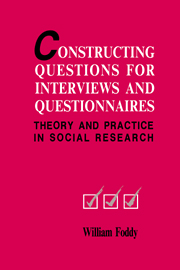Book contents
- Frontmatter
- Contents
- Tables
- Figures
- Preface
- Chapter 1 An initial statement of the problem
- Chapter 2 A theoretical framework
- Chapter 3 Defining topics properly
- Chapter 4 Formulating intelligible requests for information
- Chapter 5 Contextual influences on respondents' interpretations of questions
- Chapter 6 The need to provide response frameworks
- Chapter 7 The limitations of human memory
- Chapter 8 Filters: establishing the relevance of questions to respondents
- Chapter 9 Reducing question threat
- Chapter 10 The open vs. closed questions debate
- Chapter 11 Measuring attitudes
- Chapter 12 Checks to ensure that questions work as intended
- Chapter 13 Concluding comments
- The tap paradigm
- References
- Index
- Acknowledgements
Chapter 10 - The open vs. closed questions debate
Published online by Cambridge University Press: 04 September 2009
- Frontmatter
- Contents
- Tables
- Figures
- Preface
- Chapter 1 An initial statement of the problem
- Chapter 2 A theoretical framework
- Chapter 3 Defining topics properly
- Chapter 4 Formulating intelligible requests for information
- Chapter 5 Contextual influences on respondents' interpretations of questions
- Chapter 6 The need to provide response frameworks
- Chapter 7 The limitations of human memory
- Chapter 8 Filters: establishing the relevance of questions to respondents
- Chapter 9 Reducing question threat
- Chapter 10 The open vs. closed questions debate
- Chapter 11 Measuring attitudes
- Chapter 12 Checks to ensure that questions work as intended
- Chapter 13 Concluding comments
- The tap paradigm
- References
- Index
- Acknowledgements
Summary
Coding responses to open questions and formulating sets of response options for closed questions
Since the initial development of modern social survey techniques at the start of the twentieth century, social scientists have fallen into two camps: those who have been attracted to the use of open questions, and those favouring the use of closed questions. These two camps have become more entrenched with the passing of the decades.
On the one hand, advocates of open questions have been fortified by the thoughts of a number of the early sociologists (such as Max Weber and William Thomas), ethnographical anthropologists (such as Clifford Geertz) and more recently by ethnomethodologists (such as Harold Garfinkel, Aaron Cicourel, Jack Douglas and Charles Briggs). All of these social scientists have stressed the cultural relativity of meaning — that is, that respondents' acts must be understood in terms of the meanings that the respondents themselves assign to them — coupled with the idea that the meanings that are ascribed to an act in one situation can be very different to the meanings ascribed to it in another situation.
On the other hand, although advocates of closed questions were initially led by those involved in the development of large scale, national survey techniques and by market researchers who needed to conduct surveys quickly (e.g. Paul Lazarsfeld and George Gallup), during the last few decades the emergence of computer technology has, if anything, increased the attractiveness of closed questions for them.
- Type
- Chapter
- Information
- Constructing Questions for Interviews and QuestionnairesTheory and Practice in Social Research, pp. 126 - 152Publisher: Cambridge University PressPrint publication year: 1993
- 1
- Cited by

